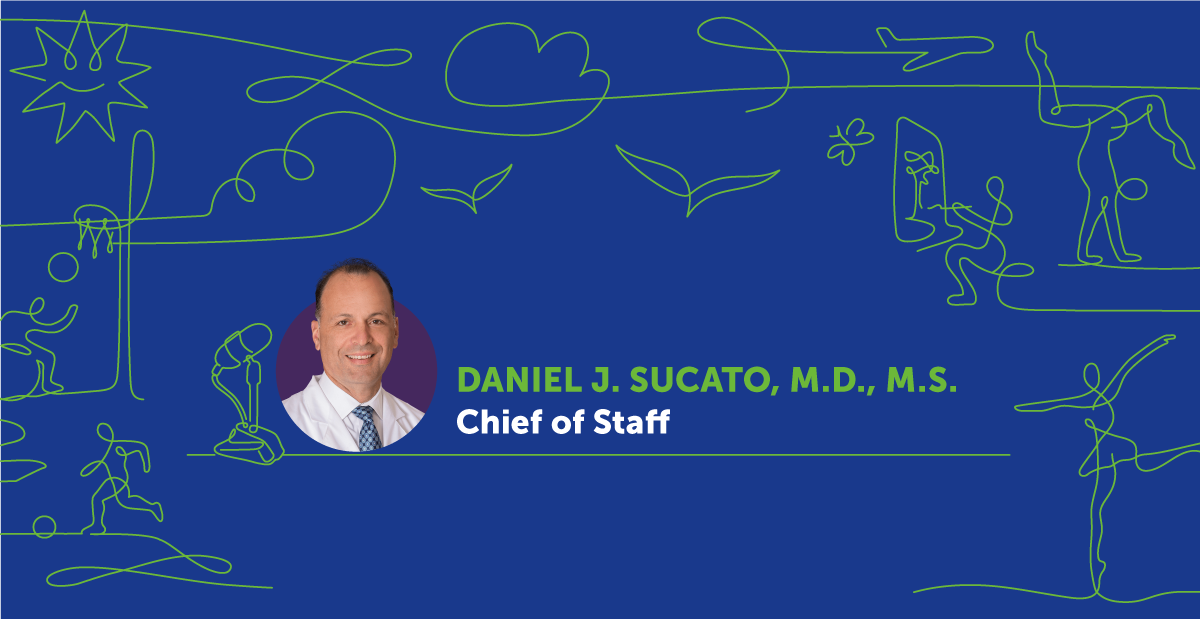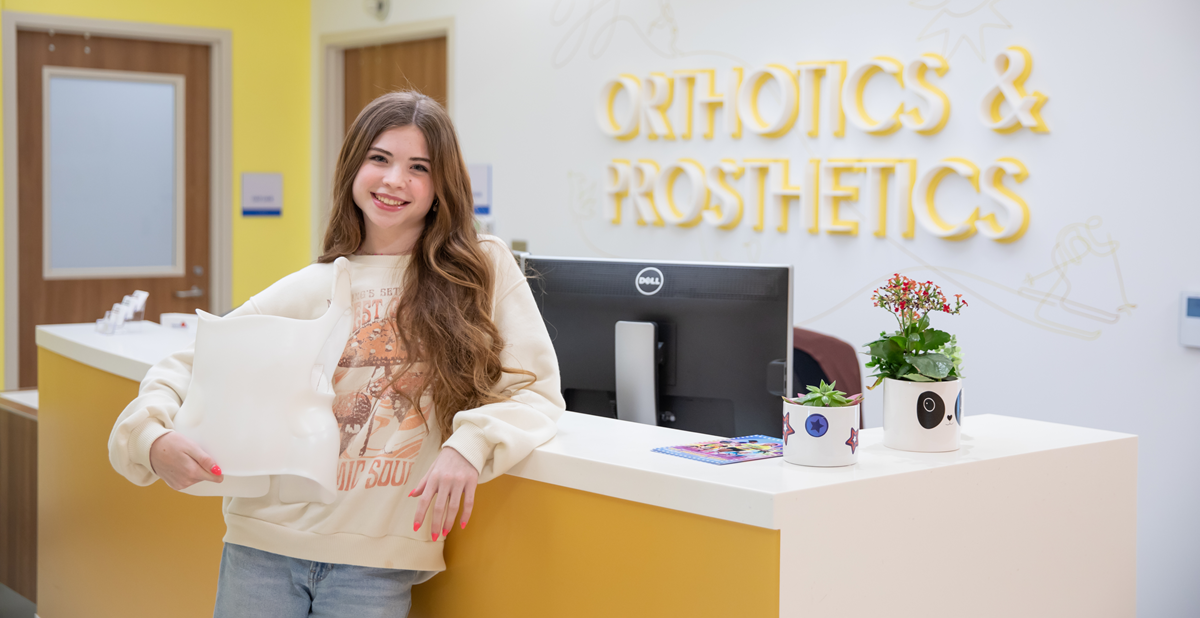
Oct 09, 2020 / Scoliosis & Spine
Checking In –Adolescent Idiopathic Scoliosis Overview
Checking In – A Scottish Rite for Children Podcast, Episode 1
Adolescent Idiopathic Scoliosis (AIS) overview
Host: Clinical Nurse Manager, Jennifer Bowden, R.N.
Expert Guest: Chief of Staff, Daniel J. Sucato, M.D., M.S.
Listen to the full episode.
Below are the highlights from this episode:
What is AIS?
Scoliosis is detected by many different people, but the two most common health care providers that we get referrals from are school nurses and pediatricians. In the State of Texas, there is mandated school screening done in middle school called an Adam's forward bend test, where children are relaxed and bend forward. What they're looking for is a rotational aspect of the spine, which goes along with scoliosis.
In other instances, parents notice signs of scoliosis when their child is in a bathing suit or when they see them in a tight-fitting T-shirt.
After an initial screening, why is it so important for children to see a pediatric orthopedic specialist about scoliosis?
The goal of scoliosis screening and the goal of treatment is to prevent curve progression. If they have scoliosis, we want to see them when they're small — when the curves are small and when the children are a little bit younger.
Growth is the main factor that causes curves to get bigger. If a child has a small curve, there are ways our team can manage that curve before needing to do surgery, and that's ultimately what we're trying to avoid.
In addition, we want to try to keep the curve as small as possible because the smaller the curve, the more likely the patient will do better going into adulthood without needing any other treatment.
At Scottish Rite, what does the first clinic visit look like for a patient with scoliosis?
When patients are referred to Scottish Rite, it's important that they receive a comprehensive evaluation. The first thing that happens is that we will get a good health history of the child to understand if there could be additional issues causing the scoliosis.
After the physical exam, we examine their back. More times than not, we will do an X-ray. Initially, when patients come to us, we like to see an X-ray that looks at the child from behind as well as looking at them from the side because it's really important to ensure that the diagnosis is adolescent idiopathic scoliosis.
The images are done in a leading-edge technology called the EOS machine – a low radiation system developed specifically for scoliosis (although it’s used for other things too). The images are top quality and capture images from behind and from the side, all at the same time. This allows us to make a three-dimensional depiction of the spine, which is really important for planning purposes.
What are the treatment options for AIS?
The type of treatment all depends on the child, the severity of their curve and whether or not they have any other underlying conditions.
Bracing:
Bracing for scoliosis has come a long way in the last 20 years and serves as the most traditional nonsurgical treatment for scoliosis. In order for bracing to be effective, the child must still be growing – meaning their growth plates are not yet closed. The goal for bracing is to prevent the curve from getting larger.
Bracing at Scottish Rite:
Another nonsurgical treatment option for scoliosis is physical therapy, also known at the Shroth method. Scottish Rite has therapists who are specifically trained in Schroth and work with patients where this treatment is an option. Learn more about the Schroth method.
Surgery
The most common type of operation is called posterior spinal instrumentation and fusion. Instrumentation refers to metal rods and screws that are attached to the spine to hold it in the corrected position. Fusion refers to the bone graft that is placed along the spine, making the vertebrae one solid piece.
Learn more about Checking In: A Scottish Rite for Children Podcast.
Adolescent Idiopathic Scoliosis (AIS) overview
Host: Clinical Nurse Manager, Jennifer Bowden, R.N.
Expert Guest: Chief of Staff, Daniel J. Sucato, M.D., M.S.
Listen to the full episode.
Below are the highlights from this episode:
What is AIS?
- Adolescent means the patient is the age of 10 or older.
- Idiopathic means we don't know the cause of it.
- Scoliosis is a curvature of the spine. So, when you're looking at somebody from either the front or from the back, you see a curve to the right or left or both.
Scoliosis is detected by many different people, but the two most common health care providers that we get referrals from are school nurses and pediatricians. In the State of Texas, there is mandated school screening done in middle school called an Adam's forward bend test, where children are relaxed and bend forward. What they're looking for is a rotational aspect of the spine, which goes along with scoliosis.
In other instances, parents notice signs of scoliosis when their child is in a bathing suit or when they see them in a tight-fitting T-shirt.
After an initial screening, why is it so important for children to see a pediatric orthopedic specialist about scoliosis?
The goal of scoliosis screening and the goal of treatment is to prevent curve progression. If they have scoliosis, we want to see them when they're small — when the curves are small and when the children are a little bit younger.
Growth is the main factor that causes curves to get bigger. If a child has a small curve, there are ways our team can manage that curve before needing to do surgery, and that's ultimately what we're trying to avoid.
In addition, we want to try to keep the curve as small as possible because the smaller the curve, the more likely the patient will do better going into adulthood without needing any other treatment.
At Scottish Rite, what does the first clinic visit look like for a patient with scoliosis?
When patients are referred to Scottish Rite, it's important that they receive a comprehensive evaluation. The first thing that happens is that we will get a good health history of the child to understand if there could be additional issues causing the scoliosis.
After the physical exam, we examine their back. More times than not, we will do an X-ray. Initially, when patients come to us, we like to see an X-ray that looks at the child from behind as well as looking at them from the side because it's really important to ensure that the diagnosis is adolescent idiopathic scoliosis.
The images are done in a leading-edge technology called the EOS machine – a low radiation system developed specifically for scoliosis (although it’s used for other things too). The images are top quality and capture images from behind and from the side, all at the same time. This allows us to make a three-dimensional depiction of the spine, which is really important for planning purposes.
What are the treatment options for AIS?
The type of treatment all depends on the child, the severity of their curve and whether or not they have any other underlying conditions.
Bracing:
Bracing for scoliosis has come a long way in the last 20 years and serves as the most traditional nonsurgical treatment for scoliosis. In order for bracing to be effective, the child must still be growing – meaning their growth plates are not yet closed. The goal for bracing is to prevent the curve from getting larger.
Bracing at Scottish Rite:
- In-house orthotists who create custom-made braces. Our Orthotics department works collaboratively with the nursing team, the physicians, the physical therapists and occupational therapists. All are prepared to provide the best comprehensive care to each patient and make sure the brace fits just right.
- Temperature sensors are placed inside each brace to help monitor brace wear. The data is reviewed at your clinic appointments and can be tracked real-time on the Brace Rite app. Learn more about the Brace Rite app.
Another nonsurgical treatment option for scoliosis is physical therapy, also known at the Shroth method. Scottish Rite has therapists who are specifically trained in Schroth and work with patients where this treatment is an option. Learn more about the Schroth method.
Surgery
The most common type of operation is called posterior spinal instrumentation and fusion. Instrumentation refers to metal rods and screws that are attached to the spine to hold it in the corrected position. Fusion refers to the bone graft that is placed along the spine, making the vertebrae one solid piece.
Learn more about Checking In: A Scottish Rite for Children Podcast.



